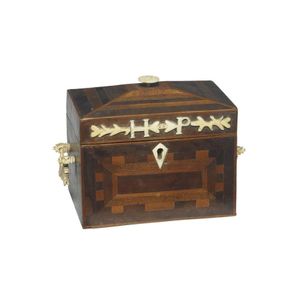
Australian Specimen Boxes: Sewing Box and Tea Caddy Pair
Wonderful pair of Australian specimen boxes, comprising a sewing box and tea caddy, both of rectangular form, set with diamond panels to the body in specimens of Australian woods, both interior fitted, 5.12 in. x 9.84 in. x 5.31 in. (tea caddy) and 3.94…

Georgian Parquetry Tea Caddy with Brass Feet and Handles
Antique Georgian specimen wood parquetry tea caddy, fitted with two caddies and central glass, standing on repousse brass bracket feet, drop ring handles to the sides, approx6.30 in. high, 11.02 in. wide, 5.91 in. deep

Rare Australian Folk Art Tea Caddy Box, 1929
A rare Australian folk art specimen tea caddy box, c.1929, made at the Wertheim piano factory. Burnley Melbourne, with inner label detailing some of the timbers used, including Queensland maple, silky oak, mountain ash, jarrah and swan bone. The top panel

Ivory Mounted Wood Tea Caddy, Australian, 1840
An Australian ivory mounted specimen wood tea caddy, circa 1840, the chamfered top and sides with parquetry decoration and applied ivory mounts, opening to a fitted interior with dual tea compartments, 7.09 in. wide, 4.33 in. deep, 5.51 in. high

Huon Pine & Rosewood Parquetry Tea Caddy, 19th Century
An Australian specimen wood inlaid huon pine and rosewood parquetry tea caddy, 19th century, the rectangular top onlaid with a pattern of three stars, the font panel parquetry work, 9.84 in. wide, 5.12 in. deep, 4.72 in. high